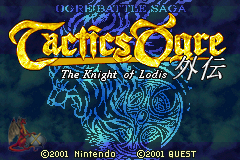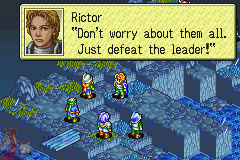 |
Tactics Ogre: The Knight of Lodis - Review |
 |
Worthy of the Ogre Name
By: Phillipe Richer
| Review Breakdown |
| Battle System |
8 |
| Interface |
7 |
| Music/Sound |
6 |
| Originality |
4 |
| Plot |
6 |
| Localization |
6 |
| Replay Value |
8 |
| Visuals |
6 |
| Difficulty |
Easy |
| Time to Complete |
40-50 hours
|
|
| Overall |
 |
| Criteria
|

|
| |
Tactics Ogre for the PSX, which originally came out on the SNES, is now considered a TRPG classic, and can fetch insanely high prices on eBay and the overall videogame market. While not being as deep and exhaustive gameplay-wise as its big cousin, Tactics Ogre: The Knight of Lodis conserves the same essence that made the Ogre series such highly praised games - and is by far the best value for the GBA. You assume the role of Alphonse, a knight of Galicia, sent on a mission on the disrupted island of Ovis, part of the Holy Lodis Empire. The southern region of Anser and the northern land of Rananculus have been in turmoil for years, and you must discover what caused these two territories to wage war against another. You'll start out with a band of mercenaries, but you'll also meet many characters along the way who want to have their part in the whole incident. Obviously, you'll quickly realize that nothing is as simple as it seems, and that bigger and stronger parties are, once again, manipulating the war behind the scenes.
As can be expected from a game with "Tactics" in its title, the game (which will be named TO from here on) is another "classic" TRPG, with battles taking place on square-grid environments. You won't be able to move freely in neither towns nor the world map. You'll be able to place up to 8 warriors on the field to battle the enemy forces. Battles take place turn by turn, and the enemy can do the same once you finish moving your troops. The whole process is rather simple: move close to the enemy, attack him, and brace yourself for his counter-attack unless you attack him from behind. Attacking from the sides or from behind inflicts more damage and lowers the enemy's evasion rate. You cannot attack and then move away, as in FFT, which decreases the amount of strategy somewhat. Most weapons have a one tile range, while whips and spears have a 2 tile reach. Bows are your only salvation if you enjoy true indirect physical combat. Some character class can also equip spells (4 max), ranging from curative, to support, to attack spells. The types of spells a class can equip are greatly restricted though. Witches can solely equip support spells and knights can only have low-level virtue spells at their disposal.
There are 14 classes total and a whole slew of different beasts, demi-humans, and undead warriors which you can either persuade to join your ranks or "buy" in shops. Some classes only apply to a certain gender, which means there are actually more than 14. In addition to spells, characters can also equip 4 items, such as a weapon, shield, armor, helmet or accessories. Adding more items means adding more weight, which then lowers the characters movement range. Movement is given in decimal, such as 6.2, and the number of tiles you can cross is always rounded down. Each class has a weapon of choice, but you can still equip whatever you want in terms of weapons. Everything can be purchased in stores. Items are used to recover HP, MP or status ailments.

|
| That's what you'll do most of the time.
|
|
Each fighter has a strength (STR), intelligence (INT) and agility (AGL) value which increase at a different rate depending on the character's class. To unlock another class, characters have to meet certain requirements in stats and sometimes in emblems or alignment. Hold on, I'll explain everything in time. Everybody has an element affinity (fire, water, wind, earth, bane, virtue) and an alignment - lawful, neutral or chaotic. Evidently, elements all have opposites which serve as weakness points. Alignments don't change much and seem to only determine what class a character can become. Strategically, the game has various terrain types, which influence both element strength and attack/defense values. Some characters are more agile in water, some are stronger on snowy plains, and some prefer dirt patches. You'll have to think about where you'll position a character, because their attack/defense value can take quite a drop sometimes. Weather is also a big part of battle. If it rains for to long on a watery battlefield, the water level may rise.
Emblems are the big attraction in terms of character building. Emblems grant special powers to the holder and are acquired by performing certain tasks. For example, you receive the Blood Reign emblem after vanquishing 25 foes, which terrifies enemies within 3 panels of the character. Some emblems serve as nothing more than class requirements. There are 32 emblems in all. The mental gauge represents the characters state. It ranges from -2 to +2, which greatly decreases/increases said person's strength. Certain classes intimidate, others boost morale.
There's also the ever elusive "personal luck", which dictates the character's attitude or mood. Determining luck is quite a pain, as you'll have to mathematically calculate it using the person's birthday, the present date (in-game) and other factors. If you want to find out how, check special FAQs, but between you and me, in doesn't affect the game the slightest. To level-up, you may wander the world map searching for enemies, or you can enter training mode, which allows you to pit people of your party against another to earn emblems and exp. You can also put everything on Auto in the training mode. I forgot to state that you start with 0 mp in battle, and that you gain 10 more every turn. You can always give it a boost with items, though.
Battles are in same vein as most TRPGs, but since you don't gain abilities depending on your class, it means you won't be doing much level building. You either like or hate the simplicity. The interface is well organized, but the biggest problem lies in the GBA. Playing the game confirmed the reason for my astonishment when the system was first released. Not having four face buttons makes thing much, much more complicated than they should be. First, to open the various menus, you have to press R, which doesn't come instinctively at first. However, when you try to organize your troops - you start swearing at Nintendo for being so god-damned stubborn. Instead of simply pressing L or R to switch between character screens, you have to press B, B, B, right, A, R, right and A. That's 8 buttons instead of one! It makes you waste a LOT of time. Shame on Nintendo, the developers did what they could.

|
| Who are you? Or does it really matter... |
|
Again, the composer, whose name I'm not certain, unloads early on with a magnificent track on the opening screen. Unfortunately, most of the other tracks fall short of the high standard set at the very beginning. There's still a good assortment of battle music, and music during cut-scenes generally conveys the right emotion, given the limits of the GBA sound department. Nevertheless, it's mostly unmemorable, though pleasant while it lasts. Sound effects are also skimpy, as many weapons have the same sound on many targets. Magic spells are alright, and since you probably won't turn the sound off while playing, it deserves a reluctant good mark.
Most of the game is an adaptation of the original TO, and as I've said many times, it looks and plays mostly like the average TRPG. Aside from the emblems, it's exactly the same as its PSX brother. Don't fret; it's a very solid foundation. TO is the first GBA RPG which doesn't admit its weak plot in exchange for simply the fun factor. While other portable RPGs such as Megaman Battle Network and Golden Sun don't try to lie out an interesting and gripping plot, TO does, and succeeds to certain extents. The multiple paths allow the player to view the actions from different perspectives. It resembles the plot of a good PSX game, with small plot twists, higher powers, and many different characters. There's also a big question of betrayal and trust. But in the end though, it seems kind of pushed, and the developers tried to give it more impact than it should really have. Some characters aren't very convincing either, and I found myself refusing the company of Alphonse's love, just because I didn't believe it. They saw each other twice! Still, it keeps you going for more, and if your expectations are low as with most GBA games, you might be pleasantly surprised.
I found myself somewhat disappointed by the script. However, there aren't many typos, as I didn't even found one. Characters don't blabber on incoherently, but their conviction isn't really heart felt. The biggest problem is that the game lacks personality in that aspect. It plays it safe, and doesn't even try to throw in a laugh or two. The huge amount of locations and name can also get confusing, and a quick manual, à la FFT, would've helped keeping things organized in your brain. TO is a very solid value. Not only does it have multiple paths, it also has different endings, although I haven't had the chance to check most of them out. Coupled with the ability to duke it out with a friend, to collect different emblems and to save anywhere, it makes a repeated visit very likely. The level building requirements is also quite decent, so you won't get frustrated along the way. The game doesn't demand enough strategy in my book, and with the ability to save at anytime during battle, it makes it a perfect game to pick up, play, and finish rather easily. Those quick battle saves aren't erased once you load either.

|
| Wow! Look at all the bright colors. |
|
While it may not make the most of the system's capabilities, the graphics are still very decent. Character classes are well represented, and the portraits are pretty nice, although they do not change to match the emotion of the speaker. Battlefields are quite large, and the weather effects are in good taste. The animations are somewhat clunky and it seems to take forever for that sword to drop down or that bow to get to its target. Spell effects aren't dazzling either, but they're vibrant and add some nice colors to the screen.
If you're looking for a great value on a GBA, or simply a great TRPG for any system, Tactics Ogre: The Knight of Lodis will not disappoint. It's interesting and deep enough to warrant more than one playthrough and the 40-50 hours it takes for a normal game is quite a long quest for any standard. I'm still somewhat bitter as it could've been one truly astonishing game, had it told a more dramatic and sentimental plot and heighten its overall level of polishing. The game is fun, it's well done, and it should become a classic like its brethren.
|










